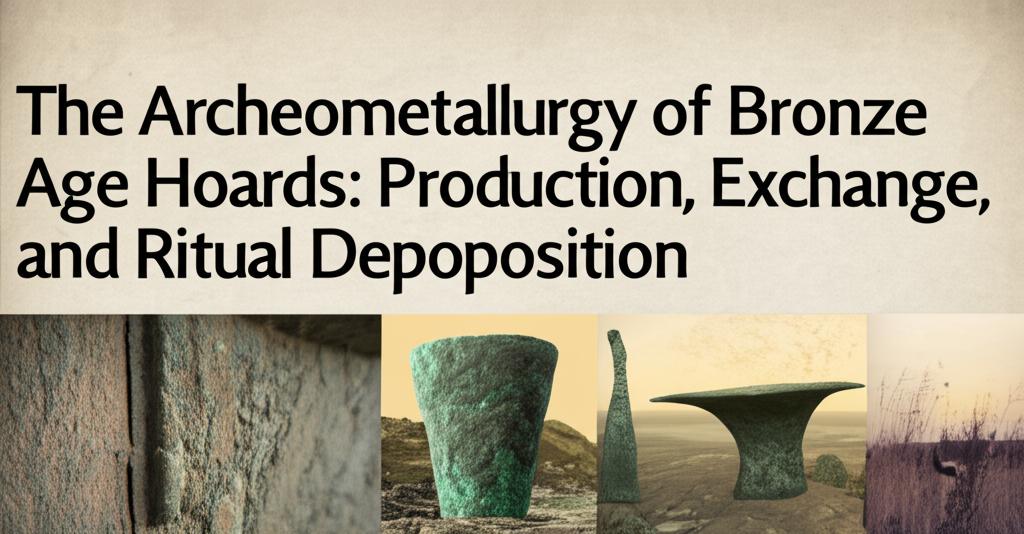Bronze Age hoards, those fascinating caches of metal objects, offer a unique window into the past, illuminating aspects of production, sophisticated exchange networks, and complex ritual practices. Archaeometallurgy, the study of ancient metalworking, plays a crucial role in deciphering the stories these hoards tell.
Production:The analysis of Bronze Age hoards reveals much about the metallurgical processes of the time. Scientific methods, including ore microscopy, trace element analysis, and lead isotope analysis, allow researchers to understand the composition of the bronze artifacts. This can indicate the types of copper ores used, the alloys created (such as copper-tin bronze or leaded bronze), and even provide insights into the casting and manufacturing techniques employed. For instance, studies have shown that Late Bronze Age smiths understood how to increase the hardness of tools and weapons, like double axes, by selectively cold-hammering their edges without subsequent reheating (annealing).
Evidence of workshops, including casting equipment like moulds and crucibles, points to an increase in local metal production in many regions during the Late Bronze Age. The study of semi-finished products, such as ingots found in some hoards, further contributes to understanding the complete technological chain, from raw ore to finished object. Some production centers may have produced surplus not only for local demand but also for wider, supra-regional needs.
Exchange Networks:The chemical and isotopic signatures of metal objects found in hoards are key to tracing the origins of raw materials and mapping out extensive exchange networks that spanned vast distances. For example, research in the western and central Balkans has shown shifts in copper sources over time. While copper from Eastern Serbia and Bulgaria was dominant in earlier periods, by the Late Bronze Age, metal from the southern and eastern Alps began to appear in the Balkans. Similarly, copper from the eastern Mediterranean, in the form of oxhide ingots, entered the eastern Balkans, highlighting connections with Aegean copper networks.
The composition of artifacts within hoards can demonstrate these connections. Studies in France have indicated differing elemental compositions of copper-based artifacts between the eastern and western parts of the country during certain periods, suggesting distinct supply networks. Later, a strong influence from Alpine cultures is evident in artifacts found as far as mid-western France. The presence of objects from diverse geographical origins within a single hoard underscores the complexity and reach of these Bronze Age trade routes. These networks facilitated not only the movement of raw materials like copper and tin but also finished goods and, importantly, the technological knowledge associated with metallurgy. Cultural factors appear to have strongly influenced these supply networks and the exploitation of specific ore deposits.
Ritual Deposition:The deliberate burial of valuable metal objects in hoards remains one of the most enigmatic aspects of Bronze Age societies. While some hoards may represent hidden caches of wealth or a smith's collection of scrap metal for recycling, a significant portion is now widely interpreted as having ritualistic significance.
Several factors support the ritual interpretation:
- Intentional Destruction: Many artifacts found in hoards, such as weapons and ornaments, show evidence of being intentionally bent, broken, fragmented, or otherwise "decommissioned" before burial, rendering them unusable. This suggests an act beyond simple storage.
- Context of Deposition: Hoards are frequently found in specific types of locations, particularly watery or wetland environments like rivers, lakes, and bogs. Such locations would have made retrieval difficult, implying a permanent offering rather than temporary safekeeping. Caves have also served as deposition sites. Some hoards accumulated over time at what are known as 'depositional sites,' where rituals and memorial practices may have occurred for centuries.
- Association with Burials: In some instances, metal hoards are found in association with human remains, suggesting a link between funerary practices and the ritual deposition of metal. For example, excavations at a dried-out lake in northern Poland uncovered Bronze Age burials alongside a significant assemblage of bronze artifacts, mostly jewelry. Radiocarbon dating suggested that human remains were placed in the lake before the metal depositions, indicating a possible transition in ritual practices.
- Symbolic Importance: The objects themselves, often valuable and crafted with skill, likely held significant symbolic meaning within their communities. Their removal from circulation through burial would have been a potent act. Axes, for instance, were sometimes produced specifically for ceremonial exchange, made impractically large or circulated in unfinished forms, emphasizing their non-functional, symbolic role.
The interpretation of hoards continues to evolve. Modern archaeological approaches utilize a multi-faceted methodology, combining typological classifications with analyses of production traces, use-wear, destruction patterns, 3D scanning for morphometric analysis, and even the study of organic remains found with metal artifacts. This comprehensive approach aims to build a "biography" of hoards, understanding them not just as collections of objects but as reflections of complex social, economic, and ritual behaviors. The debate between profane (functional) and sacred (ritual) interpretations is ongoing, with many scholars now acknowledging that these categories may not have been mutually exclusive in Bronze Age societies, and that the act of deposition itself was a culturally sanctioned social phenomenon. Understanding these practices provides invaluable insights into the beliefs, values, and social structures of the people who created and ultimately buried these remarkable metal assemblages.

